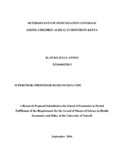Determinants Of Immunization Coverage Among Children Aged 12-23 Months In Kenya
Abstract
The Government of Kenya has made significant investments in improving immunization in the
country to prevent diseases, especially among children. Nevertheless, the country is yet to
achieve the expected 100% immunization coverage to reduce disease burden and preventable
deaths. Whereas the main aim of this study is to estimate determinants of immunization coverage
in Kenya among children of the age between 12-23 months, its purpose is to inform relevant
National Health policies to improve immunization coverage. In order to achieve its objective, the
study utilized cross-sectional data obtained from Kenya Demographic and Health Survey 2014.
The data was analyzed using the Heckman sample selection model to determine the factors that
influence immunization in Kenya. The inverse Mills ratio was found to be insignificant and
therefore the analysis relied on the probit and uncorrected OLS estimators for the analysis.
The study found that mother’s education and literacy, place of delivery, antenatal visits as well
as household head age significantly increased the chance of child being immunized. Household
size had a negative and significant effect on the probability of a child being fully immunized.
Marital status of the mother, place of delivery, antenatal visits and literacy level of the mother
had a positive effect on the level of immunization coverage. Household size, household head age
and birth order negatively affected the level of immunization coverage
Publisher
University Of Nairobi
Rights
Attribution-NonCommercial-NoDerivs 3.0 United StatesUsage Rights
http://creativecommons.org/licenses/by-nc-nd/3.0/us/Collections
The following license files are associated with this item:


